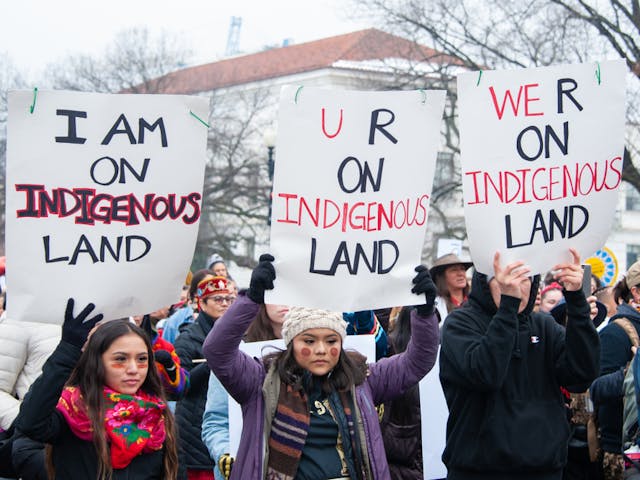Last year, I had the privilege of learning and leading as the 2022 Hawaiʻi State Teacher of the Year and a CCSSO National Finalist. After being thrown into the public arena, my image, my story and my classroom were displayed and open for critique. As I traveled across the nation, teachers shared their stories with me. One of the most heartfelt stories I heard was from a fellow Asian educator. They appreciated seeing another Asian educator receive national recognition in a profession where only 2.1% of public school educators are of Asian descent.
I sheepishly expressed gratitude while struggling with such praise. As a teacher in Hawaiʻi, I am keenly aware and reminded of my identity as a "local" teacher, one whose family heritage traces back generations in the same community. By ancestral lineage, I am gosei, five generations diasporic from Japan. I find pride in my ancestors’ survival and perseverance to separate themselves from imperial Japan and seek a better life in Hawaiʻi.

At the same time, I also recognize that my privileged experience in Hawaiʻi was forged by settler culture, the effects of which still persist in the state educational system. While 21% of teachers in Hawai’i are Japanese, only 10% have Native Hawaiian ancestry. This statistic is exacerbated by an inverse representation of students — 23% Native Hawaiian and 9% Japanese. The fact that I was selected as Hawaiʻi Teacher of the Year, despite not being a Native Hawaiian, only complicates my feeling as a settler in this community.
Often, I see educators across the US continent claiming an identity through proximity to land without any regard for its connection to Indigenous and Native communities. The off-handed remark - such as a person referring to themselves as “native Californian” - is jarring if that individual cannot trace ancestral land back to time immemorial. For Indigenous and Native peoples, who have a deep sense of place that is woven into their cultures, practices and genealogy, this can be seen as disrespectful.
Surely, there is progress to be made, and as teachers strive for equity in and out of the classroom, we must reflect on and honor the diversity of our students. Even more, for teachers of color, some of which have experienced the historical oppression of people and educational systems in this country, we must recognize and contend with our identities as settlers on the Indigenous lands of North America.
Teachers of Color
After student teaching on the US continent in a high school, I felt so isolated as the only Asian adult on campus. This feeling heightened my desire to emphasize belonging between myself and my students. We formed classroom norms and discussed how we would arrange tables and groups to strengthen our community. My intention is to always build a classroom experience where my learners feel shared ownership. No matter what the world is like outside our classroom walls, we have a space together - a respite from disagreements, biases and prejudices.
This experience was echoed by many of the educators I met over the past year. In fact, it is often the teachers - who are the only educators that hold marginalized identities - that find ways to navigate the hate against BIPOC and carve out supportive spaces for students. In these cases, support often looks like ensuring students see themselves in the curriculum, honoring the multilingual intelligence of students and engaging directly with their community and land.
It is teachers at the intersection of multiple, marginalized social identities that are changing the face of education. Still, there is much we have to unpack for ourselves for long-term, systemic change.
The Settler Identity
There are many teachers of color that can trace their arrivals - whether voluntarily or forced - back to lands occupied by the United States government. Despite our history, we must contend with the fact that we are settlers with values and beliefs that may not align with Indigenous and Native communities.
For a long time, I pondered whether I would ever feel a sense of belonging as a settler in Hawaiʻi, even in my own family's ancestral homelands. Physically, it is apparent to my students that I am a settler in Hawaiʻi. Students often express curiosity about my use of the Hawaiian language, philosophies, and insistent utility of Indigenous practices in a seemingly western science space. Conversely, I also have settler students who push back and say “it is not their culture.”
However, through my years of teaching, I've learned how important it is to remind my students that we are occupying spaces that actively displace Indigenous people, not only as a matter of fact but as a means of building a community where we can thoughtfully and respectfully honor the Indigenous and Native peoples of this land.
This is where the work must begin for my fellow settler teachers of color. We spend years learning the histories of our social identities in an effort to level the playing field in education with similar and salient experiences. For those that are fortunate to teach on Indigenous land, land that holds generations of history and culture in itself, going a step further to acknowledge this part of our identity is crucial to establishing community and honoring ancestors of the occupied land.
Our Responsibility as Settler Teachers of Color
As teachers of color continue to build inclusive spaces in education, we have a responsibility to learn and elevate the stories of the land we now occupy. That starts with asking ourselves uncomfortable questions: How are we reconciling our settler status as teachers? While we uplift Black and Brown stories of brilliance, are we actively uplifting and highlighting Indigenous ways of knowing and land-based intelligence? How are we positioning ourselves as learners of Indigenous practices? Our perseverance for equity and liberation must include all of us, and getting to the root of our identity as settlers can be a positive and meaningful step forward.
As someone who negotiates their identity as a settler teacher of color on a daily basis, I hope current and future teachers and settlers continue to create supportive spaces for students while learning just a bit more about their role as settlers on Indigenous lands.


